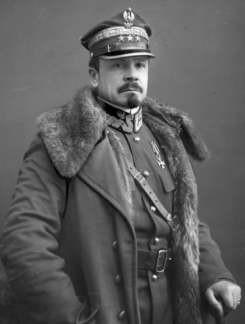Józef Haller de Hallenburg
| Józef Haller von Hallenburg | |
|---|---|

Józef Haller
|
|
| Born |
13 August 1873 Jurczyce, Austrian Poland |
| Died | 4 June 1960 (aged 86) London, England |
| Allegiance |
|
| Service/branch |
|
| Years of service | 1895–1910 1914–1920 |
| Rank | Lieutenant General |
| Battles/wars |
First World War Polish–Ukrainian War Polish–Soviet War |
| Awards |
|
| Signature | |
Józef Haller von Hallenburg (13 August 1873 – 4 June 1960) was a Lieutenant General of the Polish Army, a legionary in the Polish Legions, harcmistrz (the highest Scouting instructor rank in Poland), the President of the Polish Scouting and Guiding Association (ZHP), and a political and social activist. He was the cousin of Stanisław Haller.
Haller was born in Jurczyce. He studied at Vienna's Technical Military Academy and subsequently (1895–1906) served with the Austrian Army, resigning after reaching the rank of captain. He supported the paramilitary pro-independence Polish organization Sokół. In 1916, during the First World War, he became commander of the Second Brigade of the Polish Legion, in particular the units which fought against Russia on the Eastern Front.
In 1918, in the aftermath of the "Charge at Rarańcza", as commander of the 2nd Polish Auxiliary Corps with the Austrian Army, Haller broke through the Austro-Russian front line to Ukraine, where he united his troops with Polish detachments which had left the Tsarist army. He protested the Treaty of Brest-Litovsk and continued to fight the Russians with his II Brigade of the Polish Legions (later, the 4th and 5th Rifle Divisions of the Polish II Corps). Under the pressure of the Germans, who after the Peace of Brest-Litovsk regarded the presence of Polish troops in Ukraine as illegal, and a fierce battle between Poles and Germans at Kaniów (10 May 1918, 2500 casualties) his corps was interned, while the Brigadier himself managed to escape to Moscow. Subsequently, by the way of Murmansk, he arrived in France in July 1918, where on behalf of the Polish National Committee he created what was known as the Blue Army (from the color of its French uniforms, also known as Haller's Army). For the next few months his army, allied to the Entente, would fight against Germany. In 1919, at the new army's head, he arrived in Poland and was dispatched to the Ukrainian front. In 1920 Haller seized Pomerania and entered Danzig (Gdańsk) in the name of Poland, and during the Polish-Soviet War he commanded an army of volunteers. He was also Inspector General of the Army and a member of the War Council.
...
Wikipedia
